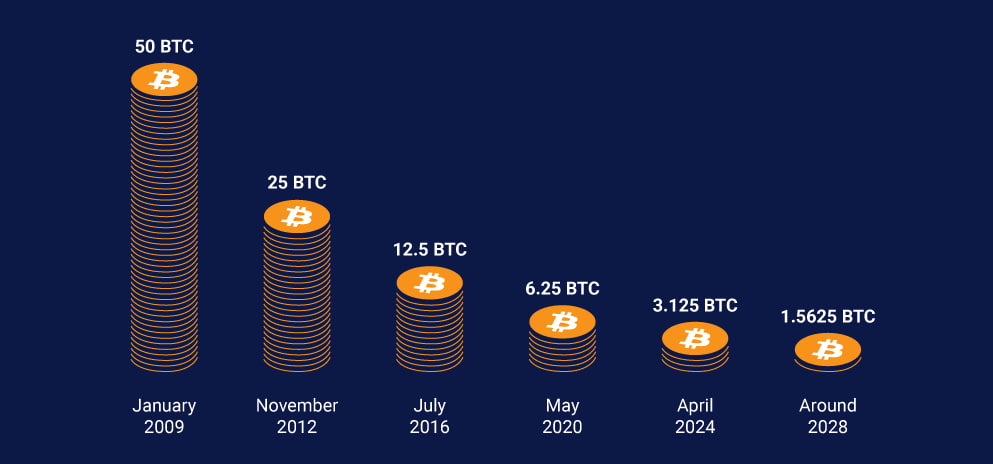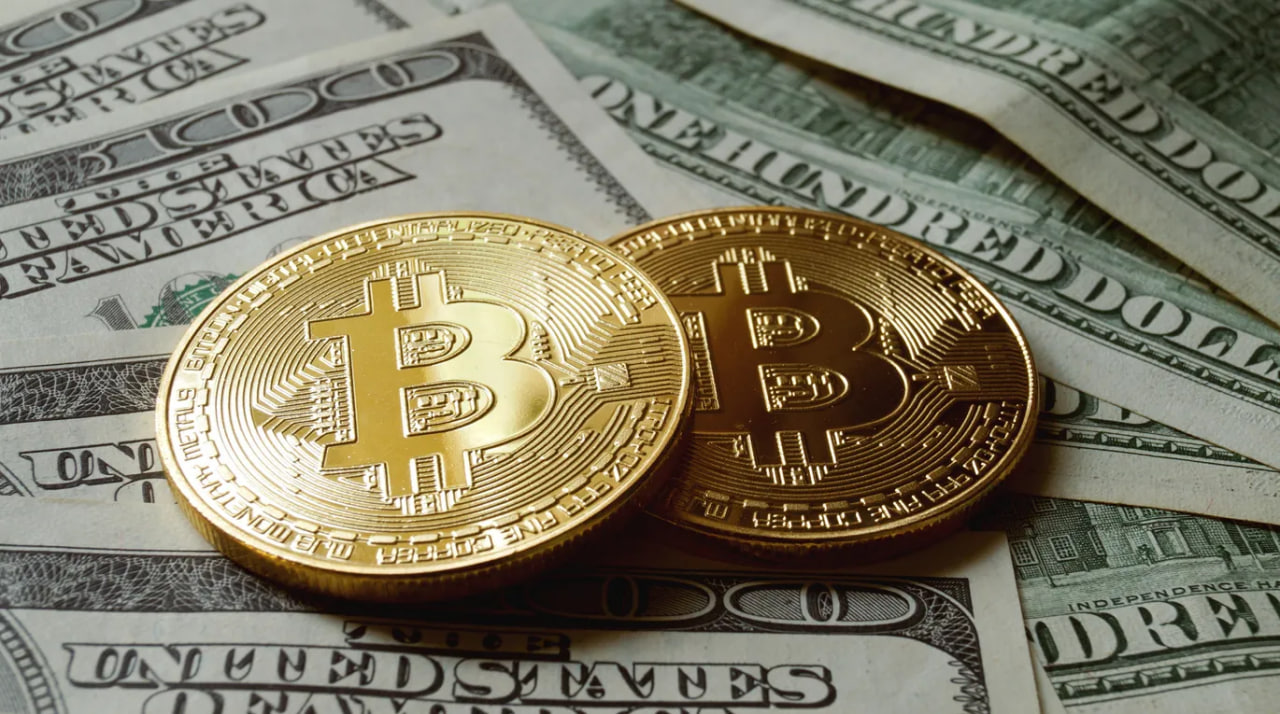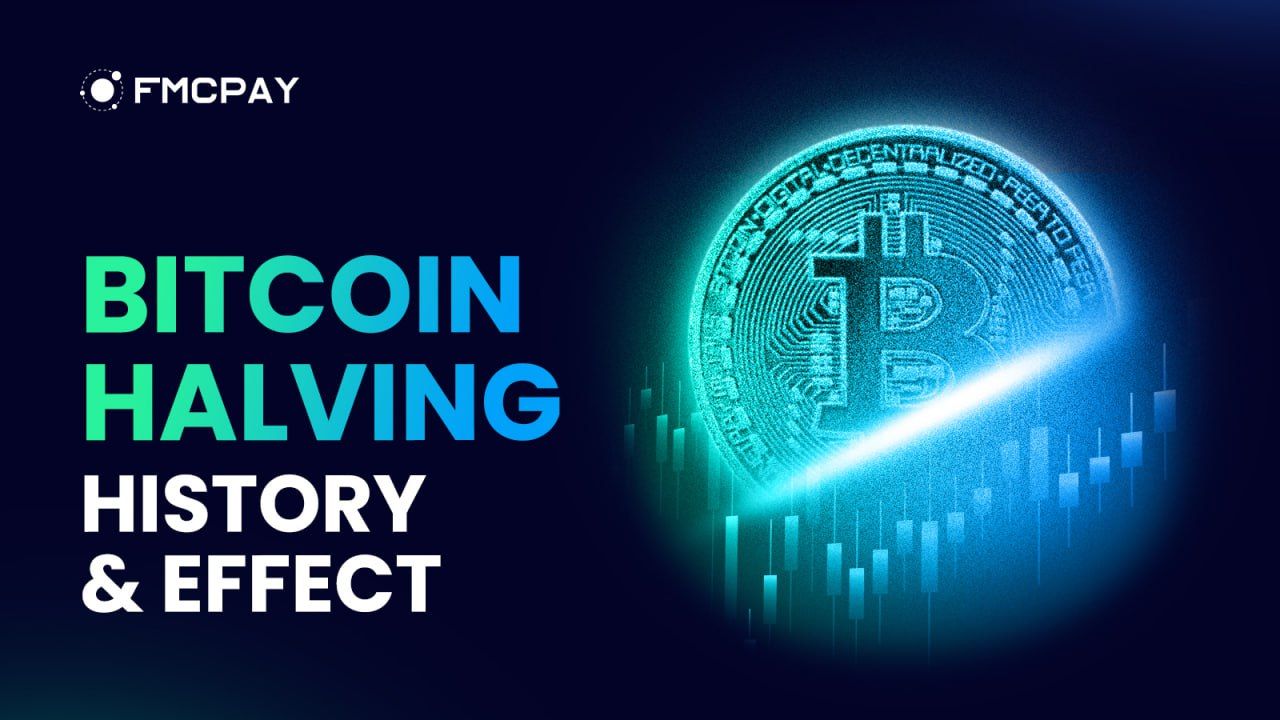BITCOIN HALVING – DEFINITION
Bitcoin Halving occurs when Bitcoin’s mining reward is splitted in half. The blockchain network takes about four years to open 210,000 more blocks, a standard set by the blockchain’s creators to continuously reduce the rate at which the cryptocurrency is introduced.
LOOKING BACK AT PREVIOUS HALVING CYCLES AND THE EFFECT TO CRYPTOCURRENCY MARKET
The previous halving cycles have resulted in a dramatic surge in the price of Bitcoin, with the main narrative centered around the reduction in supply. Specifically:
- First halving: November 28th, 2012. The reward was reduced from 50 BTC to 20 BTC. Within 12 months, BTC price rose from $12 to $1,075.
- Second halving: July 9th, 2016. The reward was reduced from 25 BTC to 12.5 BTC. Within 12 months, BTC price rose from $650 to $2,560.
- Third halving: May 11th, 2020. The reward was reduced from 12.5 BTC to 6.25 BTC. Within 12 months, BTC price rose from $8,727 to $55,847.
- Fourth halving: April 20th, 2024. The reward was reduced from 6.25 BTC to 6.25 BTC. Within 8 months, BTC price rose from $64,693 to $102,618.

INFLATION
Handling inflation concerns is one of the main ideas for reducing the payout. A decline in the quantity of things that a certain amount of money can purchase at any given time is known as inflation. The price of a basket of items is used in the United States to calculate inflation. An economy can tolerate a certain amount of inflation, often 2%, although this is normally a target established by central banks as an objective rather than a number that can be attained.
By reducing the reward amount and preserving scarcity, the Bitcoin Halving aims to counteract any inflationary impacts on Bitcoin. The inflationary impacts of the fiat currency, to which Bitcoin must be converted to be employed in an economy, are not, however, protected from Bitcoin users by this inflation “protection” mechanism.
Profits realized in relation to market value may safeguard investors against inflation, but they do not serve the purpose of using cryptocurrencies as a payment mechanism.
DEMAND
The demand for new Bitcoins often rises when there is a halving since fewer new Bitcoins are introduced. This is evident from the fact that, following each prior halving occurrence, the price of Bitcoin has essentially increased.
INVESTING
The purpose of Bitcoin was not to be an investment. It was first offered as a payment option in an effort to lessen the requirement for transactions to involve third parties or regulatory bodies.
As soon as investors realized there was a chance for profit, it gained popularity. The cryptocurrency’s creators may not have foreseen the demand created by the flood of investors into the new asset market. If the event’s consequences stay the same, a halving provides investors the prospect of a gain in investment value in addition to a reduction in the number of new coins. However, since Bitcoin investors are looking to make money, this puts Bitcoin investment in the category of speculative activity.
MINING
The persons, organizations, or companies that concentrate on mining for financial gain are known as miners. The miner(s) who earn the reward when new Bitcoins are granted have historically made significant profits. Large mining companies would not have continued to operate if Bitcoin’s price hadn’t varied over time, making it a profitable venture.
But if prices stay the same or decline, halving reduces the mining rewards, making the activity less viable with each halving. Massive sums of money and energy are needed to operate the large-scale mining operations required to stay competitive. People are needed to do maintenance on the facilities and equipment. To keep their place in the market, they must also improve their mining capabilities.
Reduced odds correspond with a decline in payout for smaller miners. Even if prices rise, miners in mining pools will probably receive fewer payouts because the reward is being reduced in half. However, unless there is a significant market event, it is unlikely that Bitcoin’s price would double to maintain present profitability.
CONSUMERS
A halving of the value of Bitcoin held by consumers and retail users may have an impact on them. The only things that often affect people who acquire Bitcoin for retail purposes are price changes, which could or might not be the same as they were before the halving.
A halving has the same meaning for remittance users of Bitcoin as it does for buyers. Following the halving event, the market price of Bitcoin will determine the amount of their remittances.
THE FACTORS THAT CAN AFFECT BITCOIN AFTER HALVING

HUGE CASH FLOW FROM SPOT BITCOIN ETFs
Spot Bitcoin ETF is seen as a crucial link to assist in bringing capital from the financial sector to the cryptocurrency market, particularly in light of the bankruptcy of several cryptocurrency institutions in 2022–2023. More than $25 billion have entered the market since the Bitcoin ETF spot was approved on January 10, 2024, or around $418 million every day. Coinbase estimates that 15-20% of all trading activity originating from CEX exchanges is accounted for by the amount of spot Bitcoin ETFs that trade daily at $4-5 billion.
Spot Bitcoin ETFs have held more than 180k BTC in less than two months since its inception, which is three times the amount of Bitcoin created during that time. The quantity of Bitcoin produced will be cut in half after 2024, with just 450 Bitcoin being awarded each day. This makes the gap between the supply and demand for Bitcoin even more pronounced, which puts positive pressure on the currency during the post-Halving phase.
As a result, the cash flow from the Bitcoin ETF Spot contributes to the increasing purchasing pressure on BTC, and the steady reduction in supply following the halving event results in a more favorable outcome than with Bitcoin as a whole.
PRESSURE TO SELL FROM BITCOIN HOLDERS AND GBTC
In addition to the previously discussed positive aspects of the growth in supply and demand, we also need to be mindful of the selling pressure coming from Grayscale (GBTC – Grayscale Bitcoin Trust) and profitable Bitcoin holders.
At the moment, GBTC has over 319k BTC (or about $21.16 billion). GBTC has sold over $16.272 billion (15 April 2024) since spot ETFs were permitted, significantly pressuring the market. The primary cause is that GBTC stockholders are profiting from the 2023 price reduction that occurred for GBTC.
Besides, it is stated that FTX and Genesis, who sold $1 billion and $1.3 billion, respectively, in January and March of this year, are to blame for the market’s recent decline. A few major corporations also switched from holding GBTC to investing in Bitcoin ETFs because of the tax benefits and cheap management fees (0.3% as opposed to 1.5%).
As per Glassnode, both long-term (LTH) and short-term (STH) Bitcoin holders experienced a profit level comparable to the 2021 bull market phase when the price of Bitcoin hit its highest point of $73.2k. When Bitcoin holders have the option to select Halving as a news purchasing or selling event soon, this also generates a great deal of selling pressure.
POSITIVE SIGNALS ARE COMING FROM MACRO FACTORS
As examined in the Report Bitcoin 2024, macro variables are crucial in guiding the direction of the financial and cryptocurrency markets over the long run. This is further supported by the recognition of Bitcoin as a novel asset class that contributes to the standard fund portfolio. The Federal Reserve’s anticipated interest rate in 2024 is one of the major factors influencing the market.
The Fed misled the market about impending interest rate reduction during the FOMC meeting on March 20, which resulted in a sharp decline in the price of bitcoin from about $60,000 to $68,000. Interest rates are expected to drop, which will result in lower borrowing costs and an increased desire to invest in riskier asset classes like Bitcoin soon.

